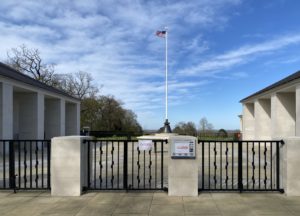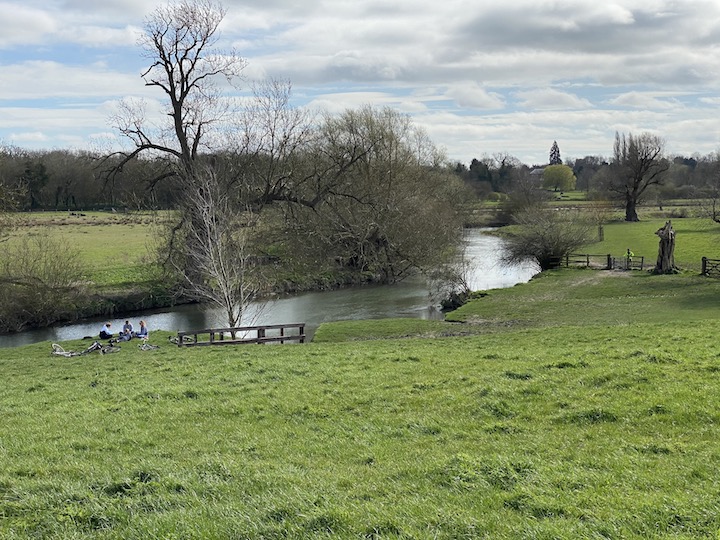If you might find it more useful to get this blog as a daily email, why not subscribe here? (It’s free, and there’s a 1-click unsubscribe). One email, in your inbox at 07:00 every morning.
The American Cemetery, Madingley this morning. Click on the image for a larger size.
Solitude vs loneliness
As the world struggles to adjust to lockdown, quarantine and social-distancing there’s an interesting and timely book on the horizon. It’s A History of Solitude by my friend and colleague David Vincent, who is one of Britain’s most distinguished social historians. It comes out on April 24. The timing is fortuitous but accidental: David has been working on the book for several years, starting on it after he had finished his previous book, Privacy: A Short History. I haven’t seen it yet, but Terry Eagleton, the literary critic, has and he’s written an interesting review for the Guardian. Snippet:
Solitude is not the same as loneliness. Lonely people feel the need for company, while solitary types seek to escape it. The neatest definition of loneliness, David Vincent writes in his superb new study, is “failed solitude”. Another difference between the two groups is that hermits, anglers, Trappist monks and Romantic poets choose to be alone, whereas nobody chooses to feel abandoned and bereft. Calling yourself “self-partnering”, meaning that you sit in the cinema (should they be open) holding your own hand, may be either a genuine desire for solitude or a way of rationalising the stigma of isolation. The greatest difference of all, however, is that solitude has rarely killed anyone, whereas loneliness can drive you to the grave. As the coronavirus rampages, some of us might now face a choice between physical infection and mental breakdown…
Thank God for experts
Producing vaccines under intense political pressure poses serious risks
How anti-vaxxers win — If any eventual vaccine harms even a tiny percentage of those who get it, “the anti-vaxxers can set back not only this vaccine but all vaccines,” said Barry Bloom, a professor at the Harvard School of Public Health. The anti-vaccine movement has been growing in the United States, and contributed to the country’s worst measles epidemic in 27 years in 2019. (From Politico’s nightly summary.)
This is yet one more reason why Trump is a menace. He keeps talking nonsense and stoking unrealistic expectations. This makes him the second biggest public health risk to the American public. And while we’re on that topic, here’s Larry Lessig:
If in January, Trump had “declared war” on this virus with the resolve of FDR, or Churchill, or even President Thomas J. Whitmore (Independence Day), he would have united the world against this common foe, and for once, the world could wage a war as one, without hesitation, and without regret.
Yet so tiny is the mind of our Idiot King that he could not even glimpse this extraordinary gift. His single focus was on the single indicator that seemed to say that he was, indeed, a genius — the stock market. And so he dissembled and obstructed to the end of faking the market out. Who knows if the man is really stupid enough to have believed that a virus that had brought China to its knees, once discovered to have infected 15 Americans, would “within a couple days go down to close to zero.” It doesn’t matter. The political system had taught Trump that he had the power to distort reality. The economic system has now taught Trump that he can’t distort economic reality. America’s economy — and the worlds’ economy— will now collapse. The election in November will be in midst of a great recession, compounded by unimaginable loss of human life. No President gets re-elected in times like that. Not the good ones. Not even the buffoons.
Remote conferencing with Zoom
Some of my research colleagues and I had a key meeting scheduled for this week and planned some weeks ago. As the University (Cambridge) went into lockdown we obviously couldn’t meet fate-to-face but were reluctant to cancel the discussion. Previously, we would have used conventional phone-conferencing, but I have become so pissed-off with the inadequacies of that medium that I suggested we used Zoom instead.
It was MUCH better. Two things in particular made all the difference: firstly one could see all the participants (as live images in small frames at the top of the screen); and secondly, whenever anyone started to speak, the software foregrounded them. This latter feature wasn’t perfect, but it was generally very effective. And the audio quality was sometimes a bit harsh, but still perfectly comprehensible.
My conclusion: the tech isn’t perfect, but I never want to go back to phone conferences again.
Why modelling is the rational way to make policy in a complex system
The Economist has an excellent explanation of the Imperial College epidemiological model That persuaded the UK government to change tack (though not quickly enough). The modellers
assigned covid-19 a “basic reproduction number” of 2.4. This means that in a population not taking any precautions, and where no one is immune, each case leads, on average, to 2.4 secondary cases.
Under those conditions the model showed the disease infecting 80% of the British population in three to four months. If 4.4% of the people infected became ill enough to be hospitalised and 30% of those deteriorated to the point of needing intensive care, then by mid-April demand for beds in intensive-care units (icus) would outstrip the health service’s “surge” capacity. In May the number of critical patients would be more than 30 times the number of icu beds available. Estimates of the fatality rate in China range from 0.5% to 1.5% of infections. Using a conservative 0.9% for Britain, the model put the death toll by the end of the summer at over half a million.
The Italian tragedy
One of the tragedies of this pandemic is the way it shows how social structures that we generally think of as embodying sociality and stability — extended families with several generations living closely together, for example — can be especially vulnerable. It turns out that Italy has a higher percentage of elderly people than most European countries, and about two-thirds of adults aged 18-35 live with their parents, with many houses containing three generations — which meant they were sitting ducks for Covid-19.




